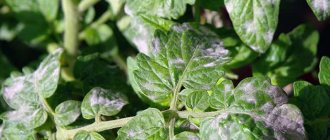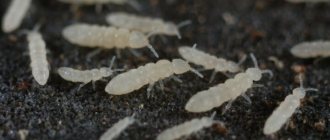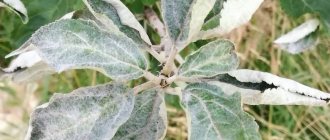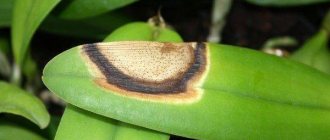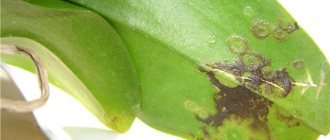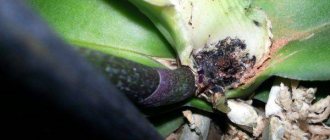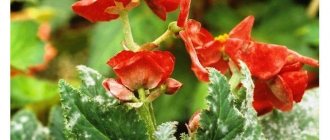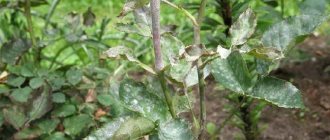Powdery mildew is an infectious disease caused by fungi. Its traces can be seen not only on flowers, but also on grain crops, fruit trees and berry bushes.
The spores of this pathogen are characterized by long-term viability. They can “sleep” in the soil for several decades.
Activation occurs when favorable conditions for reproduction occur.
There are several types of fungi. Powdery mildew on roses is caused by Sphaeroteca pannosa. Its activators are heat, high air humidity, and excessive amounts of nitrogen compounds in the soil. Rose bushes, which are dense, are most often infected. Therefore, a musty smell hovering near the plant can be considered an indirect sign of the disease.
How to identify powdery mildew and why it is dangerous
First of all, the stalks, petioles and young shoots located below the rest are infected. A white coating forms on them, in which mycelium can be recognized. After the spores mature, water droplets appear on it. In the absence of timely treatment, the ulcers spread to the entire plant.
As a result, its appearance becomes unattractive, and the aroma emanating from roses changes for the worse. This can be explained by a lack of nutrients.
Leaves affected by powdery mildew suffer from necrosis and turn yellow due to lack of photosynthesis. Flowers stop blooming, buds become very small.
The plant at the last stage of this disease is a bare stem, on the surface of which only a felt coating can be seen. Due to its structure and characteristics of the latter, the rose does not develop. The resulting cracks become a haven for rot pathogens. It is unlikely that such a bush will be able to survive the winter.
The disease has several names. In addition to the generally accepted ones, there are such popular designations as “bel”, “ashpelitsa” and “muchka”. Obvious symptoms greatly facilitate diagnosis.
Pathogens can be transferred from a diseased plant to a healthy one with the help of insects, wind or pests.
Peak fungal activity begins in June.
Signs of disease
It is quite easy to recognize the disease. It is not like other types of fungal infections. Its characteristic features include:
- The appearance of plaque on the leaf plate. Young shoots on which the fungus settles in the form of a white powder are more susceptible to infection.
- Spots on leaves. Reddish-purple spots and ulcers may appear on the leaf blade.
- Pustules on the stem. The mycelium of the fungus is localized on the stem of the rose in the form of small growths. As the disease develops, the pustules increase in area and density.
- Plant growth stops.
- Deformation and falling of leaves.
The leaves closest to the ground are affected first. In advanced forms of the disease, plaque spreads to the stems and buds. The leaves become deformed and do not return to their shape even after treatment with drugs.
A white coating covers the leaf blade, thereby creating an obstacle to photosynthesis. As a result, the plant does not receive the necessary nutrients and looks lifeless.
An equally common disease of roses, which has similar symptoms, is downy mildew. But there are some differences in its manifestation. Instead of a white coating, red-brown or purple spots appear on young leaves, and mature leaves lighten and acquire a gray tint. In this case, a dense layer similar to a cobweb is formed on the back side of the plate. These symptoms are often associated with acid rain or sunburn. This disease should be treated with a solution of boric acid (5 grams per 5 liters of water).
See also
Description and subtleties of growing roses of the Blue fou varietyRead
Causes of powdery mildew and general principles of combating it on indoor roses
There are quite a few factors that can provoke disease in plants grown at home:
- contact of healthy roses with sick ones;
- rain falling too often;
- sudden change in temperature;
- high air humidity;
- excess nitrogen and lack of minerals in the soil and other errors when carrying out agricultural activities.
To cure the disease, contact and systemic fungicides will be required. The list of the most effective ones includes Fundazol, Amistar extra, Topaz, Vitaros, Acrobat MC, Skor, Previkur.
Their action can be supplemented with spray compositions prepared according to folk recipes. Before processing, remove all damaged shoots, leaves and buds.
Gray rot
The causative agent of gray rot is fungi that appear in winter on the remains of the plant (if you do not completely remove the foliage from the roses before covering them).
Conditions for the occurrence of gray rot:
- excess nitrogen in the soil;
- wet and cool weather;
- dense planting.
Symptoms of gray rot
A light gray coating appears on the rose (leaves, buds and shoots) along with brown, rotting spots. After some time, the affected leaves turn yellow and fall off.
How to deal with gray mold on roses
As always, the best control measure is prevention. Try to regularly loosen the soil around the roses and apply fertilizers that enhance oxidative processes that prevent the development of fungi (these are manganese-containing fertilizers).
- If the disease does appear, then in the initial stages remove all diseased parts of the plant and try to create drier conditions (do not overwater the roses).
- Traditional medicine suggests using horsetail infusion in the fight against gray mold.
- If the disease has already spread to most of the plant, then it is treated with a solution of foundationazole.
- If the disease is advanced, you can use a solution of Bordeaux mixture.
Treatment of powdery mildew with folk remedies
The sooner the disease is noticed, the better. Gentle methods will give a good effect if the fungus has not had time to grow into the internal tissues. The main stage must be preceded by proper preparation, in which case the affected peduncles and leaves are removed (they are distinguished by their painful appearance and yellow color).
If the disease has been progressing for a long time, pruning should be drastic. There is no point in sparing the harvested parts of the plant.
Colonies of mycelium located in the soil are eliminated by removing the top layer of soil (if the rose grows in a pot).
When sprayed, the medicinal solution should cover the entire plant. Experienced gardeners recommend dipping the bushes completely. This is the only way to achieve maximum effect. One treatment is usually not enough; the duration of the course is determined based on the composition of the medicine.
It should be noted that traditional methods can stop the disease, but not eliminate it completely. Most often this cannot be done without special means.
Treatment should be carried out in dry weather. It is advisable that there is no strong wind and heat. It is not recommended to prepare the composition for future use. You need to do as much as you need at one time.
| Recipe | Application |
| Mix liquid soap (5 g), soda ash (25 g) and hot water (5 l). | Roses are sprayed 3 times, at least a week should pass between sessions. |
| Dilute liquid soap (1/2 tsp), baking soda (1 tbsp) in water (4 l). | The treatment is carried out three times, the interval is 7 days. |
| The solution is made from water and potassium permanganate. For 10 liters of liquid you need to take 2.5 g of potassium permanganate. | The interval between spraying is 5 days. |
| The medicine will require 10 liters of water and 1 liter of serum. | The course lasts 9 days, spraying is done every 3 days. |
| A decoction is prepared from water and fresh horsetail (proportion 10:1, respectively). Then it is infused for 24 hours, then boiled again. It should remain on the stove for several hours. After this, the liquid is separated from the solid fractions. The first is diluted with water. Take one part of the decoction to 5 parts of water. | Preventive treatment is carried out in summer and spring. |
| The medicine is made from copper sulfate (5 g) and hot water (250 ml). This mixture is slowly poured into a container filled with soap solution (5 liters of water, 50 g of soap). | In accordance with general rules. |
| 2 tbsp. l. mustard powder is diluted in 10 liters of water. | Suitable for spraying and watering. |
| Mix ash (1 kg) and warm water (10 l). The solution is infused for 7 days, remembering to stir. Liquid soap is poured into the strained composition. | Daily processing is allowed. |
| Take finely chopped garlic (25 g) and water (1 l). Mix, leave for 24 hours, filter. | The regularity of spraying depends on the condition of indoor plants. |
| Add 1 liter of whey and 10 drops of iodine to the water. | Only 2 sessions are required, an interval of 7 days. |
| You will need 10 liters of water and 3 liters of fresh manure. This mixture is infused for 3 days, the resulting liquid is poured into a separate container. Water is added to it (in a ratio of 1:10, respectively). | In accordance with general rules. |
Treatment of powdery mildew with fungicides
If traditional methods do not give the desired result, and the condition of the rosary is constantly deteriorating, you will have to use special drugs. Their functions include stopping negative processes and completely eliminating the pathogen. Additional bonuses include a restorative effect.
Fungicides can be biological or chemical.
The former are considered safer. Many people use them as growth stimulants. Unfortunately, they are not highly effective against a severely advanced disease. Drugs from this category are most often used for prevention.
Chemical fungicides can be harmful to both humans and the environment. They should not be abused. The advantages of these drugs include a fast and powerful therapeutic effect.
| Means, cost | Preparation | Application |
| Fitosporin-M 60 rub. for 200 g. | Powder: take 1 part of the drug to 2 parts of settled water. The resulting mixture is left alone for 3 hours. Paste: the composition is made from it in advance. The proportions are the same, the shelf life is much longer. To ensure fixation, liquid soap (1 tsp) must be added to the solution. | Used for treatment and prevention. The frequency of processing depends on the weather. If the summer is rainy, it should be done once a week. |
| Alirin B 80 rub. for 20 tab. | You will need 1 ml of liquid soap, 2 tablets of fungicide, 10 liters of liquid soap. The first ingredient is poured as desired. To speed up development, the composition can be supplemented with a growth stimulant (Zircon, Epin). If the solution is going to be used for prophylactic purposes, the indicated dosages are halved. | The drug prevents and treats illness. |
| Fundazol 40 rub. for 10 g. | The systemic fungicide can be purchased in powder form. For 10 liters of water there are 10 g of the drug. | Spray three times. |
| Tilt CE 300 rub. for 100 ml. | For 1 liter of liquid take 0.4 ml of concentrated emulsion. | The therapeutic effect lasts for 2 weeks. The treatment is carried out if the air temperature is below +30 °C. |
With prolonged use of the same drug, pathogenic microorganisms develop addiction.
Helping the plant: anti-fungal drugs
Fungicides are popular treatments for powdery mildew on rose bushes. Such targeted drugs will be effective in case of mass infection of the rose garden. The instructions for each drug must be strictly followed. Excess of active substance can damage the plant.
How to spray a rose garden, examples of preparations:
- Fundazol,
- Soon,
- Topaz,
- Raek,
- Quadris,
- Maksim,
- Topsin et al.
Dosage of drugs
The use of biofungicides is a more gentle way to save a flower garden from powdery mildew. These drugs cause much less harm to the environment. Live bacterial cultures contained in biological products suppress the growth of fungus.
Examples of biofungicides:
- Fitosporin-M,
- Planriz,
- Alirin-B,
- Gamair tablets,
- Pseudoacterin-2.
Chemicals are used before flowering, or at least a month before harvest. Biofungicides can be used at any stage of development.
Video with ways to treat rose gardens for fungal diseases.
Tips for treating plants:
- Fungicide preparations should be alternated so that the fungus does not develop immunity. The same products are used no more than three times.
- When spraying, you should use protective equipment. All garden tools should be disinfected both before and after use.
- Before processing, you need to remove all affected parts and burn them, and clean all plant debris around the bush.
- After spraying, you can supplement the treatment procedure by watering the tree trunk circle. For watering, use a used product or another preparation with a similar effect.
- The optimal time for spraying is early morning or evening; it should be dry and windless, or preferably cloudy.
- Leaves are sprayed from all sides. With extensive damage, you need to pay attention to the entire bush.
- To prevent the spread of fungal spores throughout the area, treatment is carried out not only in the rose garden, but also on other plants susceptible to powdery mildew.
- Treatments are carried out until the signs of the disease completely disappear.
Mr. Summer resident recommends: measures to prevent the disease
Powdery mildew is easier to prevent than to cure. To reduce the risk of infection of rose bushes, you must:
- promptly remove affected parts of the plant;
- regularly weed the rose garden;
- When planting, observe crop rotation;
- carefully select seed material;
- feed garden crops, following the recommendations of specialists and taking into account the initial condition of the soil;
- choose rose varieties resistant to powdery mildew;
- disinfect instruments.
Prevention will not take much time. In order for the rose garden to remain a decoration of the garden plot throughout the warm season, you need to strictly follow the plan of agrotechnical measures. Otherwise, the appearance of powdery mildew, its false variety and parasites, for example, aphids, cannot be avoided.
What to do as a preventive measure?
To prevent powdery mildew fungus from disturbing the rose garden, they resort to preventive measures:
- Roses are planted in sunny and windless places.
- The soil for planting should be loose, nutritious, with neutral acidity.
- A sufficient interval is maintained between seedlings, the minimum distance is 25-50 cm. Planting of bushes depends on the characteristics of the variety. Tall specimens are located further than dwarf ones.
- The tree trunk circle must be dug up, all weeds and dry leaves must be removed.
- How to treat bushes to prevent the development of powdery mildew? As a preventative measure, rose bushes are treated with Bordeaux mixture in early spring before flowering and in late autumn after leaf fall. After eliminating the disease, treatment is consolidated with additional fungicide treatment.
- Among fertilizers, preference is given to organic matter and potassium-phosphorus complexes. Nitrogen-containing preparations are used until mid-July. Before flowering, superphosphate and potassium nitrate are applied under the bush. These fertilizers increase the resistance of roses to fungus.
Treatment - If powdery mildew is detected, the leaves are plucked from the bush. All leaves and shoots on which spores can overwinter must be removed.
- The bushes should be watered at the root with warm water, preferably rainwater. 1-2 waterings per week in summer are sufficient.
- It is better not to plant crops susceptible to disease in one place for 2 years in a row.
- Choose rose varieties that are resistant to fungus.
More often than others, powdery mildew fungus affects remontant varieties and hybrid tea roses. These species should be given special attention.
The fight against powdery mildew on garden roses will only end in success with an integrated approach. A gardener who takes care of the health of the flower garden at the planting stage will have bushes less susceptible to fungal and other diseases. Preventive measures reduce the likelihood of harmful consequences to a minimum.

